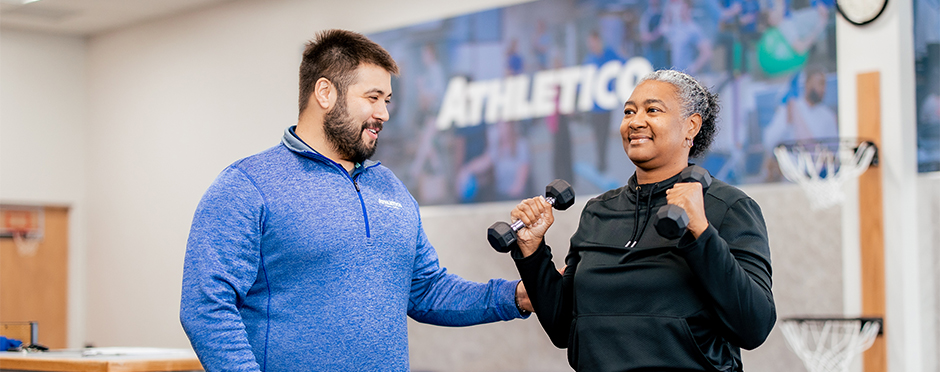
Should I Exercise If My Joints Make Noise?
Leave a CommentDo your joints make noises when you move? Many people hear noises such as pops, creaks, or grinding in their joints, often in the knees, with activities such as going up stairs or squatting down. But it’s important to know that these noises can be normal, especially if they are not associated with any kind of pain! When joints make noise, it is commonly known as crepitus. Let’s take a closer look at what crepitus is and what you need to know in order to continue safe exercise.
What Is Crepitus?
Crepitus is any grinding, crunching, creaking, cracking, or popping sound that occurs when moving a joint. Crepitus can occur at any age, but it becomes more common as we get older. Sometimes the noise is muffled, and sometimes it can be loud enough for others to hear.
Crepitus can be caused due to several different and common factors. Air bubbles in the joint can pop, and generally this does not cause pain. A tendon or ligament can snap across the bone making a noise which may or may not cause pain. Arthritis causes the degeneration of the cartilage on the ends of bones, which can lead to more grinding between bones and can cause crepitus. This may or may not cause pain.
What Should I Do About Crepitus?
In general, crepitus alone is not a cause for concern. It is normal for joints to make some noise. If your crepitus is accompanied by pain, swelling, or other symptoms, then it can be checked by a medical professional.
Can I Work Out With Crepitus?
Studies have shown that crepitus is more common in those with other diagnoses associated with knee pain. However, knee crepitus alone has no negative effect on function or physical activity level2. We know that many people have negative thoughts and a negative emotional response to crepitus1. Due to these negative responses, many people will alter their behavior to avoid the crepitus, oftentimes avoiding workout type activities1. Many times, people get fearful when they hear noise in their joints. With this fear, many people are worried about hurting themselves or causing damage to the joints. Therefore, they stop doing activities. However, joints make noise, and that can be normal.
Another study found that patients with crepitus self-report more pain and lower function, however no differences were found in walking or knee strength for those with or without crepitus3. This shows us that many people have negative thoughts about their joints making noise and will self-limit their activity as a result. However, you don’t always need to limit yourself!
So, in short, YES you can work out even if you have crepitus! Especially if you have no pain with the movements, you can continue to do your workouts. The noise we hear does not always mean anything is getting worse or injured. If you are having pain, you can try modifying the activity to reduce the load and improve the muscle activation around the joints.
If you do experience prolonged pain or soreness, let our team take the first look to help you get back to a safe and pain-free workout routine. Connect with a movement expert for a free assessment where our team will assess your pain at its source and provide an expert recommendation for next steps to help you feel your best. Free Assessments are available in-person and virtually through our Telehealth platform.
*Per federal guidelines, beneficiaries of plans such as Medicare, Medicaid, Tricare, VHA and other federally funded plans are not eligible for free assessments.
The Athletico blog is an educational resource written by Athletico employees. Athletico bloggers are licensed professionals who abide by the code of ethics outlined by their respective professional associations. The content published in blog posts represents the opinion of the individual author based on their expertise and experience. The content provided in this blog is for informational purposes only, does not constitute medical advice and should not be relied on for making personal health decisions.
References:
1. Robertson CJ, Hurley M, Jones F. People’s beliefs about the meaning of crepitus in patellofemoral pain and the impact of these beliefs on their behaviour: A qualitative study. Musculoskelet Sci Pract. 2017 Apr;28:59-64. doi: 10.1016/j.msksp.2017.01.012. Epub 2017 Feb 2. PMID: 28171780.
2. de Oliveira Silva D, Pazzinatto MF, Priore LBD, Ferreira AS, Briani RV, Ferrari D, Bazett-Jones D, Azevedo FM. Knee crepitus is prevalent in women with patellofemoral pain, but is not related with function, physical activity and pain. Phys Ther Sport. 2018 Sep;33:7-11. doi: 10.1016/j.ptsp.2018.06.002. Epub 2018 Jun 6. PMID: 29890402.
3. Pazzinatto MF, de Oliveira Silva D, Faria NC, Simic M, Ferreira PH, Azevedo FM, Pappas E. What are the clinical implications of knee crepitus to individuals with knee osteoarthritis? An observational study with data from the Osteoarthritis Initiative. Braz J Phys Ther. 2019 Nov-Dec;23(6):491-496. doi: 10.1016/j.bjpt.2018.11.001. Epub 2018 Nov 16. PMID: 30471964; PMCID: PMC6849337.
